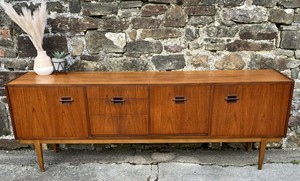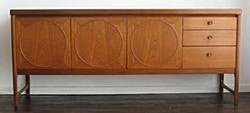Nathan furniture

B & I Nathan was a furniture maker that followed contemporary taste in the 50s, 60s and 70s. Like G-Plan, Nathan emphasised the value of its brand, trading on an image of quality and craftsmanship. Nathan furniture followed rather than set trends in the 50s and 60s. The company moved slightly more up market at the end of the 60s and produced some innovative designs that inspired a large group of loyal customers to furnish their homes in Nathan's distinctive style: modern, but with a traditional feel.
Nathan furniture in the 50s
In the 50s, like other brands, Nathan went contemporary. The firm followed the fashion in the late 50s into Tola (African mahogany) furniture, with black, ebonised legs and brass handles. This dining room suite, right is a good example of the 50s' contemporary style. The chairs are covered in an abstract patterned material and have black ebonised frames. The sideboard is in Tola with brass handles.
Nathan furniture in the 60s
Nathan retained this look into the early 60s. In this they were a little behind some of the other manufacturers that were already experimenting with more fashionable teak furniture.
In 1963, Nathan went Scandinavian. Their advertisements proclaimed 'Scandinavian Design By Nathan'. Nathan's first range of teak furniture was called 'Citadel'. It had a classic Scandinavian low, long sideboard, which was simple and elegant with no decoration other than plain recessed handles. At 6 feet in length, it was still large and provided ample storage, but was more suited to a semi-detached house than the massive 7ft sideboards that some of the more expensive firms sold.
Nathan introduced several other dining suites on the same theme: modern, Scandinavian inspired, designs in teak. All began with the letter "C": Corsican, Corinthian and Cortina. The top of the range, the 7ft Corinthian sideboard, right, had the added luxury touch of rosewood handles. Rosewood was expensive and used by only the best manufacturers. Manufacturers at the cheaper end of the furniture market added small touches in rosewood to make their teak furniture more glamorous. This advertisements shows the glamour and style of the world the furniture makers were selling to their customers. The room layout is minimalist and modern, the lady is sipping a cocktail, and even the telephone was aspirational in the mid sixties.

In the late 60s Nathan moved further upmarket. Many manufacturers were making teak furniture, so designs needed to be original. They introduced several new designs in teak. One of the best was this sideboard with a circle pattern cut into the veneer on the doors.
These new designs continued into the early 70s. Nathan then took a different course.
Nathan in the 70s

Nathan furniture in the 70s acquired a more traditional look. These units, right, are from the mid 70s. The doors have a traditional Jacobean feel, yet the concept of units was modern, as was the material, teak, which remained the first choice for most buyers throughout the 70s. The setting on the right looks like a typical suburban dining room from the 70s. Nathan may have been aiming at a slightly more mature buyer. Younger people were either shopping at Habitat, or more likely going to a discount warehouse to buy furniture in the 70s.
Buy retro Nathan furniture
If you are interested in buying Nathan furniture, we recommend eBay as the place to start. A large amount of Nathan is sold on eBay and prices are substantially lower than you would pay from a dealer.
By Steven Braggs


Comments
I have a Nathan cabinet from the 70s and the plastic hinge mounting bracket broke. Anyone know where I can find spare parts for Nathan furniture?
Hi Lesley
Nathan used Teak veneers for the panels and the solid wood used such as the door framing was African walnut.
Hi,
Is the retro squares range all made from teak & teak veneer ? I know some of the coffee tables had beech legs just wanted to be sure before I strip and restore various charity shop treasures to furnish my bedroom.